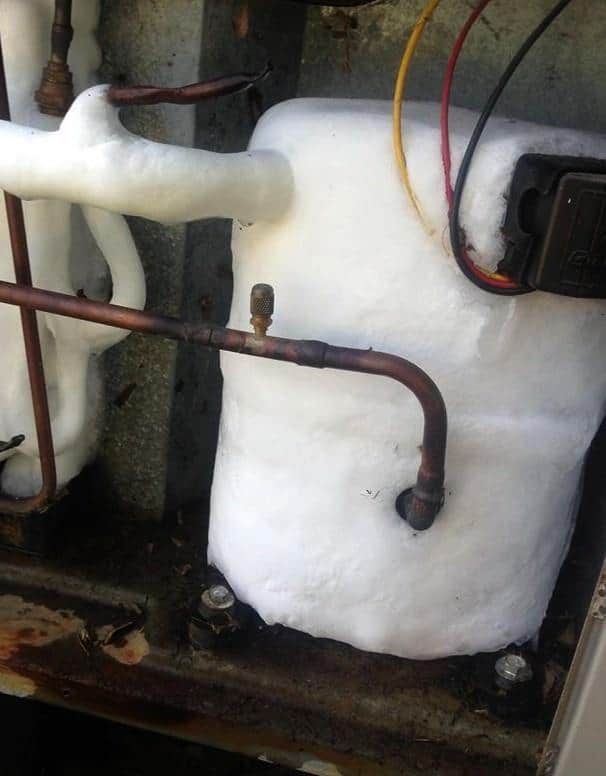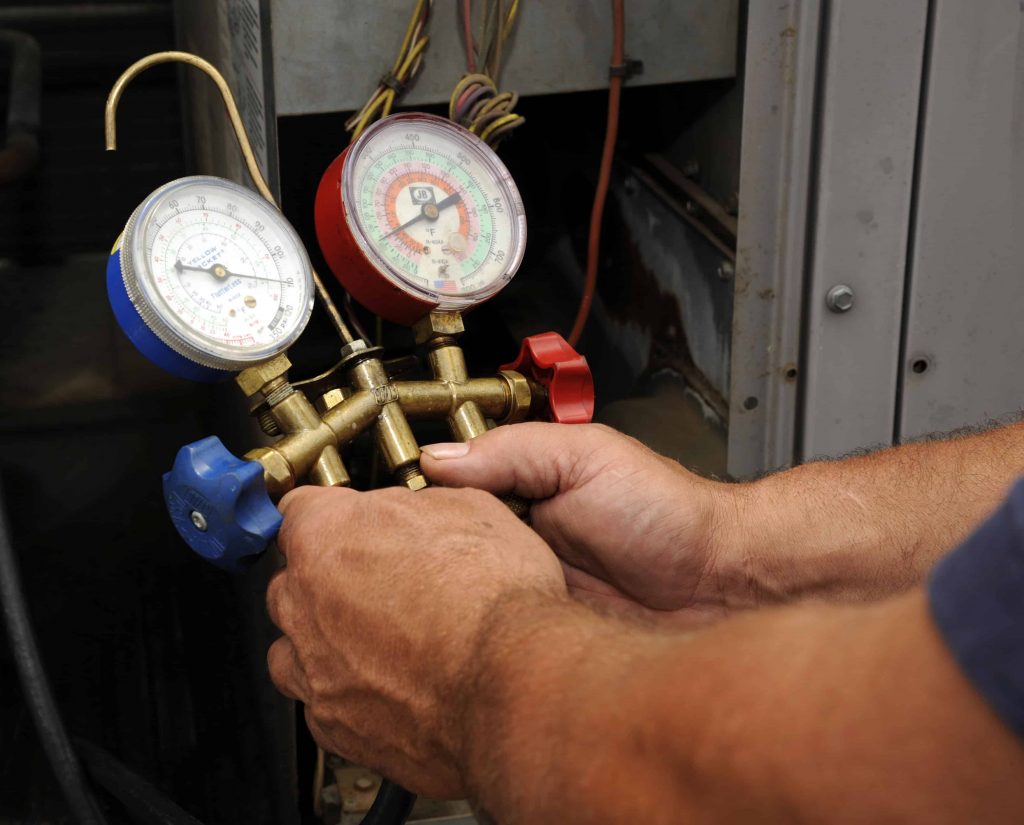AC Refrigerant Leaks will sooner or later prevent your system from cooling your home. It will also cost money in terms of your cooling bill. If left undiagnosed for too long, it can also cause major component failure as well. It is also one of the most common HVAC issues per energy.gov.
AC Refrigerant Leaks
Learn what this means to you as a homeowner
What is refrigerant?
Refrigerant is a chemical that produces a cooling effect while expanding or vaporizing. Most residential air-conditioning units contain the standard R-22 refrigerant or freon. There are two types of refrigerant in use today.
R22
The old standard for residential air conditioners, now being phased out by the U.S. In 2020, R-22 will no longer be produced or imported. After 2020, only recovered, recycled, or reclaimed supplies of R-22 will be available. The production (not use) of R-22 is being phased out. You are not required to stop using R-22 air conditioners nor to replace existing equipment. The phase out period provides time to switch to ozone-friendly refrigerants when you normally would replace your air conditioner. In the future, R-22 supplies will be more limited and costs to service equipment with R-22 may rise. Read more in our recent blog post on this phase-out.
R-410A
A chlorine-free refrigerant that meets the U.S. EPA’s newest, most stringent environmental guidelines. R-410A was developed as an alternative to R-22 (freon), which will be phased out over the coming years in response to international environmental concerns. R-410A contains no chlorine, so it’s not damaging to the atmosphere’s ozone layer. As an added benefit, independent testing has shown that R410A allows higher heat transfer than R-22, resulting in more efficient operation.
Why do leaks happen?
An air conditioner or heat pump (if you have a heat pump) does not consume Freon or refrigerant. The system is a sealed system and the air conditioner does not burn or use up refrigerant to make your house cool. Your AC System should never have to be filled up unless a leak occurs in the system. Heating and air conditioning systems are supposed to be sealed but leaks do happen on occasion.
A correct and precise charge is important so that it can continue doing its job of cooling the home. As the refrigerant leaks out the system still cool. It actually cools too much. The indoor evaporator coil begins to freeze up because the temperature of the evaporator coil drops below the dew point. This is humidity or moisture in your home or business which passes through the air conditioning (or heat pump) indoor coil (evaporator) for conditioning. The refrigerant in your air conditioner is supposed to be locked in a hermetic system and sealed tight.
What are the signs of AC Refrigerant Leaks?
- The air being blown in is not as cool as it should be – Refrigerant plays an extremely important role in the cooling process. It’s the refrigerant’s job to absorb the heat from your home and release it outside. If your refrigerant levels are depleted, it will take longer to cool your home or business, which often results in a visit to the thermostat for a downward temperature adjustment.
- Warm air is blowing into your house instead of cool air – One part of your quick analysis for an AC refrigerant leak is to check the air coming from your registers (vents). If the air is not as cold as it should be, it could mean an HVAC refrigerant leak.
- Indoor AC makes a hissing noise – An AC refrigerant leak is caused by holes or cracks in the coils that circulate the refrigerant. Though hissing could be a sign of a variety of problems, refrigerant leaks are among them. A larger leak may produce a gurgling sound.
- You see frozen coils on your AC Unit – When the refrigerant levels circulating through the evaporator coils is insufficient, the coil swill not adequately absorb heat. This will result in the condensation on the coils to freeze. Sometimes the frozen condensation will begin to melt and drip on the floor. Though ice on the evaporator coil might not seem alarming, it could lead to a system breakdown and could translate into an expensive repair such as a compressor replacement.
- Higher Electric Bills – If an AC refrigerant leak is negatively impacting your comfort level and causing you to dial down the thermostat in the hope of getting cooler air, you will be using more electricity. Review your utility bill for inconsistent usage levels especially when compared to the same timeframe last year.

Where do AC refrigerant leaks happen most often?
The most common locations for a leak to occur at are:
- The Shrader valve is leaking Freon and needs to be replaced. There is a tool which can be used to change this Shrader valve without having to recover the entire amount of refrigerant from the system. These Shrader valves look like the little valves in your tire on your car and they hold the refrigerant in the system and allow the technician to access the system to test the pressures or to charge the system if necessary.
- Heat Pumps have something called an accumulator. Accumulators are necessary for the heat pump system to provide heat in the winter and protect the compressor from liquid slugging. Accumulators are usually made from steel and after a few years, they begin to rust. These rust holes allow Freon or refrigerant to leak out of the heat pump system.
- A capillary tube is leaking on the inside evaporator coil or if you have a heat pump on the outside heat pump condensing unit. These capillary tubes are very small copper tubes and over time and through the vibration of the system they rub together or rub against another piece of metal and a hole appears on the capillary tube.
- If the air conditioning or heat pump system has any flare connections leaks generally occur at these connections. Sometimes these flare connections can easily be repaired while other times the flare fitting and connection have to be replaced and remade completely to prevent future leaks in your AC unit.
- The indoor or outdoor air conditioning or heat pump coil is leaking and needs repair or replacement. Most of the time the leaks in the coils (whether they be outside or inside coils for an air conditioning or heat pump system) occur at the u-tubes or bends in copper at the end of the coil.
- Filter dryers are installed in all AC Units. These filter dryers have screens and desiccant inside them and the outer shell is made of steel. The same problem that occurs with a heat pump accumulator will eventually occur with a filter dryer and a refrigerant leak occurs.
- The line which carries refrigerant back and forth from the condenser to the evaporator coil has been pierced or damaged. Damage can occur from a lawnmower or someone tripping over the line set.
How does an AC Leak detection work?
There are 3 main ways to find or locate the refrigerant leak.
- Most HVAC service technicians keep an electronic leak detector or sniffer in their toolkits. As the name suggests, the HVAC tech runs this tool along the refrigeration components to detect any R22 or R410a outside of the system. Most HVAC technicians will start a leak test by using this device, as it can be more cost-effective in finding a leak. This will only find AC refrigerant leaks where the tool can touch the components in the system.
- A nitrogen leak detector test—the preferred test by Bayside AC technicians—adds a greater degree of clarity to leak detection, though for slightly more cost. With this test, we first remove any remaining freon or Puron and pumps compressed nitrogen into the refrigeration system. The leaks become audible because the nitrogen is held at a higher pressure than the refrigerant can operate under normal conditions. Imagine when you pump air into your bicycle tire, and you can hear the air coming out. It’s the same concept here. In addition to listening for audible signs of a leak, HVAC technicians will also be watching the gauges to see if pressure changes. In a system without leaks, the pressure will remain constant. A system with a leak will show fluctuations. Our technician will mix up soap bubbles, spray or coat components of the refrigeration system, and look for air bubbles.
- A dye test for freon or Puron leaks can also be applied. Here, an HVAC technician adds ultraviolet dye to the system, looking for both constant and intermittent leaks. The UV dye mixes with lubricants within the system and finds its way to even the smallest leaks. The technician uses a blue/black light to see the dye as it leaks out.

Call Today
Call Bayside Heating and Air Conditioning Today!
(727) 669-4300
